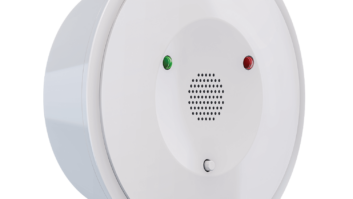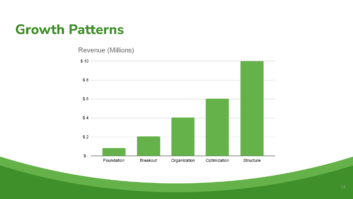The custom installation market is growing rapidly, causing dealers to turn away business due to a lack of skilled personnel. That leaves todays dealers with two choices: either live with the dilemma or make skilled personnel more efficient.
Because ignoring the problem wont increase profits, lets focus on making people more efficient. Fortunately, the lighting and control community will soon have new technologies that dramatically improve efficiency by a factor of 2X, and sometimes even better. Table 1 demonstrates what 2X efficiency could mean for a $1 million/year integration company.
Selling Efficiency. The Old Way: The dealer had a scope and budget meeting using the clients roll of drawings to sketch where keypads and dimming modules went. Then he created lists and wiring tables to keep track of his parts and wiring. The next step was to look through the manufacturers voluminous parts list for numbers and prices. And, if he wanted to prepare a first-class proposal, he would hire a CAD professional to overlay the floorplan drawings with his design highlighted. Needless to say, this process typically took days.
The New Way: Emerging software technology will make the dealers life a whole lot easier. Proposals that took days now take a few hours, and the client gains confidence in the salesmans professionalism.
First, the salesman imports the clients floorplan into a computer program using the new software tools and then simply drags and drops system modules and loads them onto the plan. Then, by pointing and clicking, he automatically wires the system and creates documents useful not only for himself, but also for the designer, the installer, the electrician, and the parts manager.
When the client sees the new plan overlaid on his familiar floorplan, he smiles. And, when the salesman turns on the lighting simulator in a test room, the client immediately understands and appreciates the value of a lighting and control system.
The results are dramatic: after working on a 10,000-square-foot home proposal for just two to four hours, the salesman is ready to have a closing meeting with his client. The floorplan-centric software eliminates days of effort and creates a professional, full-sized set of drawings that impress clients.
The software simultaneously generates the drawings and an accurate bill of materials, dramatically reducing the possibility of dealer errors and minimizing the need to pay for unplanned parts. And, when the plan is initialed, both dealer and client have a document, which minimizes misunderstandings that always seem to surface at the end of a project.
The Old Way: Covering small, medium, and large jobs entailed choosing different systems for each. Carrying three unique solutions was complex, and meant extra costs, training, and parts count. As a result, many dealers chose to limit their market scope to only certain job sizes.
The New Way: Under the new model, scalable hardware will open up new markets for the dealer. New, scalable hardware with distributed intelligence can competitively handle anything from the smallest home theater to a 50,000-square-foot house. Those smaller jobs suddenly become profitable, while changes in scale are easy.
Design Efficiency. The Old Way: The designer used to be in the unenviable position of turning the salesmans dog-eared drawings and handwritten notes into an up-to-date working document. Its not hard to see how this process could produce delays and costly mistakes.
The New Way: With emerging software technology, designers and programmers can produce fast, error-free designs and updates. The designer simply clicks on a floorplan object and then relates it to other system modules, e.g. a single keypad button could control several dimmer legs throughout the house. This fast, intuitive floorplan-based programming then produces a drawing showing what switch relates to what loads (virtual wiring). It also automatically creates high-voltage wiring plans for electricians while simultaneously creating low-voltage wiring plans for installers. The program even checks to see if any loads have been left unwired or unprogrammed.
The lighting simulation capability, previously used during the proposal stage as a selling tool, is also a valuable tool to test programming. It enables the programmer to test his work at the office instead of at the clients site, which reduces travel time and lots of after-dark hours on site.
The Old Way: The volume of SKU (part) numbers was daunting. Salesmen, designers, parts managers, and installers were bewildered by the thousands of SKU choices. Mechanical parts, such as custom faceplates, covers, color choices, screws and brackets, plus electrical parts such as cable types, connectors, adaptors, and special firmware, all took their toll. Keypads were engraved, forcing the dealer to order a special new part for each change request. Installer mistakes were commonplace; delays were unavoidable, and unused inventory collected dust, all creating extra cost and undermining efficiency.
The New Way: With multipurpose hardware design, designers can minimize SKU count. Multipurpose hardware has dramatically reduced SKU counts from thousands down to double digits, relieving dealers of their bewilderment. For example, new keypad designs with inkjet printouts can be modified on site and printed within minutes, using a wide selection of font styles and sizes.
Installation Efficiency. The Old Way: Installation was exasperating, as the trades required lots of handholding to get their jobs done. It didnt help when they had old marked-up drawings and inadequate documentation. Working with others on a job site chewed up a significant amount of an installation managers time.
The New Way: Emerging software technology and familiar IT tools lower the blood pressure and increase efficiency for all of the players. The new software can be edited and kept up to date in minutes or seconds, thereby eliminating the waiting time for others to produce it. Armed with accurate documentation, the dealer now has professional communications tools to hand to other trades on site. The electrician gets a complete set of high-voltage wiring plans and the low-voltage guys get theirs. These drawings answer a lot of questions that would normally be directed to the installation manager.
And speaking of installers, now that millions of trained wire pullers and technicians understand IT technology, why not take advantage of that knowledge? Well, its happening. New lighting and control systems are being designed around Cat-5e wiring and standard RJ45 connectors with combined data and power, so installation managers can access a talent pool that needs little or no training. That means fewer mistakes, faster troubleshooting, and more money for the dealer.
Maintenance Efficiency. The Old Way: When the client had a system problem, he called the dealer who, typically blind about the problem, dispatched one of his high-level techs. Unless the tech had exactly the right repair parts, this turned into a two-trip process.
The New Way: With web-connected system monitoring and smart system devices, the dealer will often know about a problem before the client does. As a bonus, the dealer can plan maintenance activities rather than simply reacting to problems. A new self-monitoring, web-connected system automatically sends an e-mail when a problem occurs. The system often catches problems even before the homeowner knows they exist. Servicing the house is more efficient because the dealer knows in advance what the problem is and sends the proper replacement parts with the repairman. Additionally, the repairmans skill level can be lower since the new system automatically re-programs replacement modules once theyre in place. The repairman only needs to know to remove the offending module and replace it with a new oneno ID switches to set, no programming necessary.
The Old Way: After moving in, the client wanted some scene changes. Because the dealer wanted to encourage good future references, he tried to be responsive. However, an after-dark follow up visit is expensive and time consuming, so the dealer was forced to charge for the call.
The New Way: In the future, the dealer will make the changes from his office via the web in a few minutes while the client gives him guidance over the phone. He can call up the system via a secure web connection, reprogram it to the new scene and test it. He can even download new software and firmware features without making site visits. Both parties are happy and appreciate the minimal effort to complete the job.
By adopting emerging new technologies, lighting and control dealers will soon witness a dramatic upturn in the efficiency of their skilled personnel. Making better use of the scarce resources already available, dealers can easily double or even triple profits.
Bill Beierwaltes is the CEO of Colorado vNet and holds BSEE, BSMath and MBA degrees. An entrepreneur for most of his career, he has started five companies. Beierwaltes makes a habit of doing serious due diligence, thoroughly investigating the best technologies.






